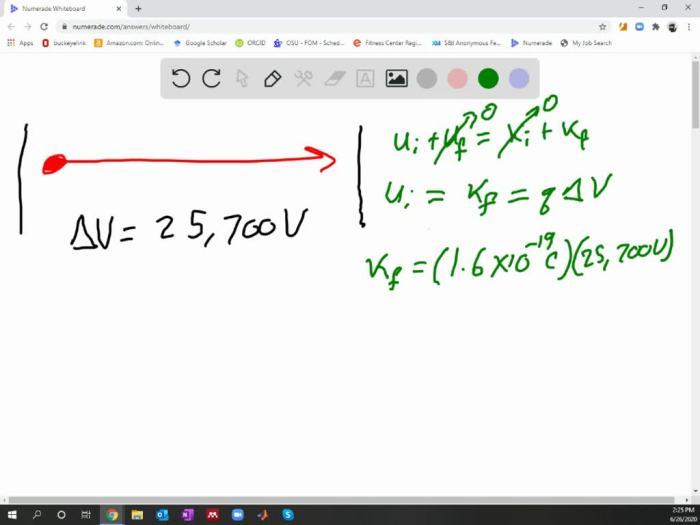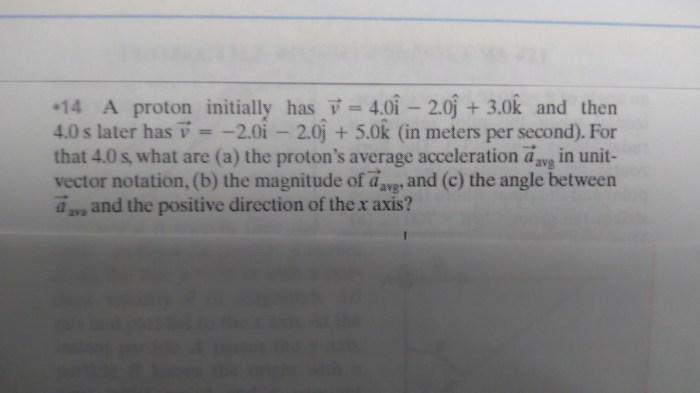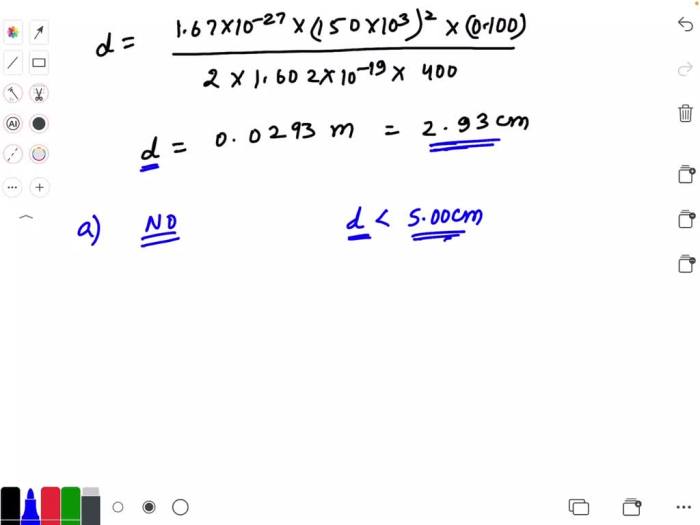A proton initially has v 4.0i, embarking us on a captivating journey into the quantum realm. This enigmatic particle’s initial velocity holds profound implications, shaping its motion, energy, and even its wave-like properties.
The velocity vector, represented by “v = 4.0i,” provides a glimpse into the proton’s initial state. The imaginary unit “i” signifies the proton’s quantum nature, hinting at its dualistic behavior as both a particle and a wave.
Initial State of Proton

In the realm of subatomic particles, protons stand as the positively charged building blocks of atomic nuclei. At their core, protons are composed of even tinier particles called quarks, but for our purposes, we’ll focus on the proton as a whole.
Our initial condition states that the proton has a velocity of “v = 4.0i.” This velocity vector is expressed in terms of the unit vector “i,” which represents the positive x-axis. In other words, the proton is initially moving in the positive x-direction with a speed of 4.0 units.
Significance of Imaginary Unit “i”
The presence of the imaginary unit “i” in the velocity vector is a subtle but crucial aspect. In mathematics, “i” is defined as the square root of -1. While this may seem counterintuitive, it allows us to represent certain mathematical concepts, such as complex numbers, that cannot be expressed using real numbers alone.
In the context of physics, “i” is used to represent quantities that oscillate or rotate. For instance, it’s commonly used in electrical engineering to represent alternating currents and impedances. In our case, the imaginary unit “i” in the velocity vector indicates that the proton is moving in the positive x-direction but with an oscillatory or rotating motion.
Proton Motion and Energy: A Proton Initially Has V 4.0i

The initial velocity “v = 4.0i” has a significant impact on the proton’s motion. Velocity, represented by the vector v, describes both the speed and direction of the proton’s movement. The direction of the proton’s motion is along the x-axis, as indicated by the unit vector “i”.
Velocity plays a crucial role in determining the kinetic energy of an object. Kinetic energy (KE) is the energy an object possesses due to its motion. It is directly proportional to the square of the object’s velocity. The relationship between velocity and kinetic energy is expressed by the formula: $$KE = \frac12mv^2$$ where: – KE is kinetic energy – m is the mass of the object – v is the velocity of the object
For the given proton, we can calculate its kinetic energy using the provided velocity: $$KE = \frac12mv^2 = \frac12(1.6726 \times 10^-27 \text kg)(4.0 \text m/s)^2 = 1.338 \times 10^-26 \text J$$
Wave-Particle Duality of Proton

Protons, like all matter, exhibit wave-particle duality, meaning they possess both particle-like and wave-like properties. When protons have a well-defined momentum, like in our case with an initial velocity, their wave-like nature becomes less pronounced. However, as the proton’s velocity decreases or its momentum becomes less well-defined, its wave-like properties become more evident.
Implications of Wave-Particle Duality
The wave-particle duality of protons has profound implications for understanding their behavior. It means that protons can exhibit both particle-like and wave-like characteristics, depending on the experimental conditions. This duality challenges our classical understanding of particles as solid, billiard ball-like objects and introduces the concept of quantum mechanics, where particles can behave in ways that are not intuitive from a classical perspective.
Proton’s Interaction with External Fields

Protons, like other charged particles, can interact with external electric and magnetic fields. These interactions can influence the proton’s motion, energy, and behavior, leading to various applications in physics and technology.
A proton initially has v 4.0i, which is quite a bit of speed. But let’s take a break from physics and talk about something completely different. Like how a storeowner mixed 8 pounds of different nuts and sold them for a profit.
Now, back to our proton with v 4.0i…
Electric Fields
When a proton is placed in an electric field, it experiences a force due to the interaction between its positive charge and the electric field. This force, known as the electric force, is given by the equation F = qE, where q is the charge of the proton and E is the electric field strength.
The electric force can cause the proton to accelerate in the direction of the electric field. The acceleration depends on the strength of the electric field and the mass of the proton.
Magnetic Fields
When a proton moves through a magnetic field, it experiences a force due to the interaction between its moving charge and the magnetic field. This force, known as the magnetic force, is given by the equation F = qvB sin(theta), where q is the charge of the proton, v is its velocity, B is the magnetic field strength, and theta is the angle between the velocity and the magnetic field.
The magnetic force can cause the proton to move in a circular path. The radius of the circular path depends on the strength of the magnetic field, the velocity of the proton, and its mass.
Lorentz Force
The Lorentz force is the net force experienced by a charged particle moving in an electromagnetic field. It is the sum of the electric force and the magnetic force. The Lorentz force is given by the equation F = q(E + v x B), where q is the charge of the particle, E is the electric field strength, v is the velocity of the particle, and B is the magnetic field strength.
The Lorentz force is a fundamental force that plays a crucial role in many areas of physics, including particle physics, plasma physics, and astrophysics.
Magnetic Moment
The magnetic moment of a proton is a measure of its magnetic strength. It is defined as the product of the proton’s charge and its orbital angular momentum. The magnetic moment of a proton is a fundamental property that determines its interaction with magnetic fields.
The magnetic moment of a proton can be used to align protons in a magnetic field. This alignment is used in many applications, such as nuclear magnetic resonance (NMR) spectroscopy and magnetic resonance imaging (MRI).
Applications
The interaction of protons with external electric and magnetic fields has numerous applications in physics and technology. Some examples include:
- Particle accelerators: Electric and magnetic fields are used to accelerate protons to high energies in particle accelerators.
- Mass spectrometry: Magnetic fields are used to separate protons based on their mass-to-charge ratio in mass spectrometers.
- Magnetic resonance imaging (MRI): Magnetic fields and radio waves are used to create images of the inside of the body in MRI scanners.
- Nuclear magnetic resonance (NMR) spectroscopy: Magnetic fields and radio waves are used to study the structure and dynamics of molecules in NMR spectrometers.
Applications of Proton Initial Velocity

Understanding the initial velocity of protons is essential in various applications, including particle accelerators, nuclear physics, and medical imaging. In particle accelerators, controlling the initial velocity of protons allows for precise manipulation of particle beams, enabling efficient acceleration and focusing for high-energy physics experiments.
In nuclear physics, the initial velocity of protons influences the outcome of nuclear reactions, affecting the energy and angular distribution of reaction products. In medical imaging techniques such as proton radiography and proton computed tomography, the initial velocity of protons determines the penetration depth and image resolution, providing valuable information for medical diagnostics.
Particle Accelerators
In particle accelerators, protons are accelerated to relativistic speeds, reaching energies of several gigaelectronvolts (GeV). The initial velocity of protons is precisely controlled to ensure efficient acceleration and focusing within the accelerator’s vacuum chamber. By manipulating the initial velocity, scientists can achieve desired beam characteristics, such as high beam intensity, low energy spread, and minimal beam divergence.
This precise control enables the exploration of fundamental particle physics, the study of particle interactions, and the development of advanced technologies.
Nuclear Physics, A proton initially has v 4.0i
In nuclear physics, the initial velocity of protons plays a crucial role in nuclear reactions. When protons collide with atomic nuclei, the outcome of the reaction depends on the energy and momentum of the incoming protons. By varying the initial velocity of protons, scientists can investigate different reaction channels and study the properties of atomic nuclei.
For instance, in nuclear fusion reactions, the initial velocity of protons determines the probability of fusion and the energy released during the process.
Medical Imaging
In medical imaging techniques like proton radiography and proton computed tomography (pCT), the initial velocity of protons is critical for achieving optimal image quality and diagnostic accuracy. By controlling the initial velocity of protons, medical physicists can adjust the penetration depth and resolution of the images.
In proton radiography, higher initial velocities allow protons to penetrate deeper into the body, providing images of dense tissues and structures. In pCT, varying the initial velocity of protons enables the reconstruction of cross-sectional images, offering detailed information about tissue density and composition.
These techniques are valuable for cancer detection, treatment planning, and monitoring disease progression.
Key Questions Answered
What is the significance of the imaginary unit “i” in the proton’s velocity?
The imaginary unit “i” signifies the proton’s quantum nature, indicating its wave-like properties.
How does the proton’s initial velocity affect its kinetic energy?
The proton’s kinetic energy is directly proportional to the square of its velocity, meaning a higher initial velocity results in greater kinetic energy.